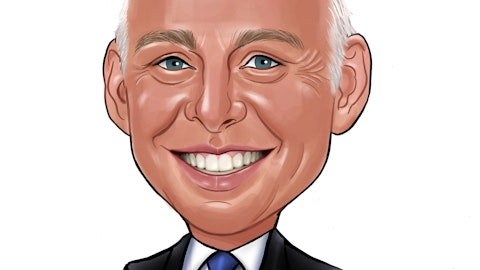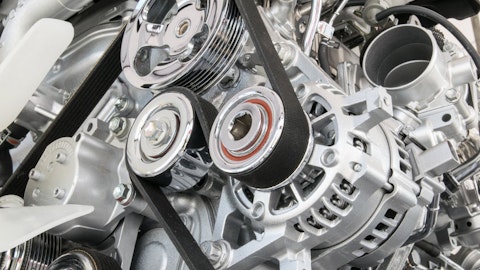Matt Koranda: Okay. And then just lastly, can you level set everybody on cash flow expectations for the rest of the year? I know you deferred or you said, you deferred like $15 million. And AR collection so that’s a good guy for the third quarter maybe just speak to can we expect positive cash flow from operations in the third quarter and the fourth quarter of this year? And then maybe just if you want to thread in or talk about any of the inventory or AR dynamics that we should think about for the rest of the year as it pertains to working capital.
Selwyn Joffe: Yeah. So working capital neutrality is probably becoming a buzzword for NPA internally. So first of all, let me answer your question is yes we expect positive cash flow for the back six months. We generated $30 million, essentially generated $30 million in the first six months. We don’t know why we couldn’t do that in the back six months, that we will have to wait and see. The other side of it is, I mean, increased gross margins increased EBITDA increased work on days outstanding on payables and neutralizing working capital. Yes, there will be some growth in working capital for the new business that comes on no question about that. But that will be quickly reversed as that new business kicks in and the sales kick in from that. But again, we’re very focused on cash flow. We’re very focused on stable growth. And we expect things to continue on this trend line.
Matt Koranda: Okay. Appreciate all the answers. So I’ll leave it there.
Selwyn Joffe: Thank you.
Operator: [Operator Instructions] Our next question comes from the line of Brian Nagel from Oppenheimer. Please go ahead with your question.
William Dossett: Hey, good afternoon. This is William Dossett on for Brian. Thank you for taking our questions. So you’ve discussed that demand remained strong and that’s consistent with the update that you gave back in August. Can you just discuss probably the drivers of the strength? And I wanted to ask about for guidance any range of outcomes that you’ve potentially embedded and perhaps the key areas of upside and downside?
Selwyn Joffe: Yeah. So again, what’s driving our business is number one we continue to have great market share. Number two, we have price increases. And the most important piece is that the fundamentals of the aftermarket continue to be really strong. And our customers’ inventory level someone asked I didn’t answer that properly in the last question, I’ll address it now. Customers need inventory. And this is non-discretionary parts when the consumer needs to replace that part. The customer has it. We don’t believe that there’s excess inventory in the channel at all. We think there’s still opportunity for growth in inventory in the channel quite frankly. And so that’s another tailwind. And the average age of the car park continues to go up.
Miles driven seems to be at least stable to positive. And so I just — I don’t see — we have as an industry every now and again you get a blip in a product demand and people try and describe what that is but that’s somewhat of an unknown. But overall these cars need these replacements and they’re going to have it. And so I think there’s overall strength everywhere for us. I think the upsides for us new business opportunities that we have and that we were ramping up for. So there’s upside there. I think there’s upside in the margin opportunity. Clearly, from price increases, but also from overall production efficiencies. Challenges are you never know again whether it can cause short-term blips. There’s always a risk that you can lose business, but we hope we’re not on that side of it and we don’t expect that.
But overall, we’ve used the outlook for our business very positively right now.
William Dossett: Thank you for that. And to follow-up just on your point, have you seen any short-term blips that you suspect that there has been at all any deferral amid higher inflation? And then to that point, is there any point at which you think price elasticity comes into play just with the cost increases for purchases?
Selwyn Joffe: Yeah. So I mean, we’ve had blips and then we’ve had some large customers have had some challenges and that they’re coming out of that and they’re still coming out of that. So there’s some more upside in that. So that has caused some blips for us. I mean our fundamentals for our business have been really strong, but we had some unusual customer blip now last fiscal year. So we see the back of that. We are optimistic that all of our customers continue to be strong. I think we see a little slower ramp up and now some parts of our brake business, but very strong. But that’s because of some slowdown and changeovers but we expect that to recover. So again, I think overall, there’s some deferral in demand in our product lines.
I think that’s coming. But again, the day-to-day fundamentals the registered fundamentals that we see for our product lines, but really positive. In terms of price elasticity, we have non-discretionary products. So I mean to the extent that these products cost more and that’s validated I mean we expect that that demand should not be affected by price increases. I think that overall the consumer choices to either repair the vehicle or scrap it. And if you look at the relative value of the vehicle versus the repair the repair makes all the sense in the world unless they’re absolutely unable to make a repair then that have to resort to public transportation. But we see the non-discretionary nature basically overcoming any pricing obstacles or short-term pricing obstacles and that those prices can be pushed through and should stick.
And the disproportionate value of the repairs still very much positive for the consumer and then alternative starters et cetera, et cetera the cost of them compared to the value of the vehicles and the alternatives are miniscule. So we see plenty of upside.



